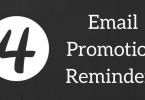
This is the fourth post in our series comprising The Beginner’s Guide to Restaurant Email Marketing. View our first post on getting started here, our second post on selecting a vendor here, and our third on updating your email templates here.
We’ve been pretty outspoken about your need, as a restaurant marketing leader, to improve your email marketing creative.
More personalized.
More creative.
With this post, we share a mix of basic and advanced email marketing metrics you should be tracking.
1. Open rate.
What percentage of your recipients open your emails? Your email marketing provider should provide this for every campaign you send. There are a few really good sources out there sharing their benchmarks for open rates from the restaurant industry.
- Benchmark Email states the restaurant industry email open rate average is 26.2%.
- Mailchimp states the restaurant industry email open rate average is 24.6%.
- Mailer Mailer states the restaurant industry email open rate average varies based on list size, ranging from 9.5% (list size > 1,000), 21.9% (list size 500-999), and 30.9% (list size 249-499).
How do you compare?
2. Click rate.
What percentage of your email recipients click on any link in your emails? Again, this is a no-brainer that every email marketing provider needs to provide. Here’s what those three providers suggest is average for the industry:
- Benchmark email states the restaurant industry email click rate average is 3.4%.
- Mailchimp states the restaurant industry email click rate average is 1.6%.
- Mailer Mailer states the restaurant industry email click rate average is 0.6%.
Huge differences there, huh? This reinforces how important it is to test and tweak. Don’t get into a rut, publishing the same emails over and over.
3. Unsubscribes.
Once your email list gets to a certain size, you need to accept the fact that people are going to unsubscribe. It happens. Don’t take it personally, until this number gets out of hand.
Having said that, you should test and tweak to keep this rate below 1%. How often you send and, obviously, WHAT you send, impacts this number.
If what you send is relevant, engaging, fun, rewarding, and enticing — or some combination of these — you’ll probably be fine. I can promise you this, though: send too often (like, daily) and you’re going to annoy your most ardent fans.
4. Bounce rate.
There are two kinds of “bounces” — hard and soft. Hard bounces are undeliverable emails. People give you their work email address and quit the job? That email is probably going to hard-bounce.
If your list is manageable, you can quickly scan it from time to time, looking for typos such as “.cmo” instead of “.com”, for instance. Listen, I sometimes type my own name “Brandno” instead of “Brandon” and don’t notice until I hit Submit on a web pages.
Of course, if your email list requires double opt-in, these typos shouldn’t persist, but it’s good to check anyway.
Soft bounces are email addresses that are temporarily unavailable for some reason. Maybe their mailbox quota has been exceeded; or there’s a temporary local connection problem. It can even come from an out-of-office reply with some email accounts.
5. Redemption rate.
With every campaign you send that involves an offer, you’ve got to track what percentage of your emails lead to offer redemptions.
Does it go without saying that you BETTER be getting rock-solid redemption rates for any birthday email offers you send? Like, above 35%? Well, we said it anyway. You’ve got to nail it with personalized offers.
For example. I have one chain that sends me offers every week. When my birthday came around last year, I got nearly the exact same offer I received from the chain the previous week — that ALL of us on their email list received, I should say. That’s a missed opportunity. If you collect my birth date, show me some love on that once-per-year special day and give me a share-worthy offer.
The range of redemptions for other offers can be pretty wide though — as low as 2%, as high as 20%.
Want to add one killer redemption per year across your entire list?
Follow Freebirds‘ example: give consumers a half-birthday offer that’s super special. Have your vendor setup a calculated field that adds 6 months on to their birth date, call it their Half Birthday, and you’re golden.
What affects redemption rates? The offer, of course. But just as much as the offer is the window of time a consumer has to redeem the offer.
It doesn’t have to stop there. Are you ready for this?
We’re very, very, very close to restaurants being able to regularly track not only redemptions, but return visits.
Imagine this scenario: You’ve sent an email to your list with an offer. You’ve seen that 25% of the list opened the email, 5% clicked on the offer to view and print it, and 2% redeemed it.
But what would it mean to you to know that 20% of your email recipients returned to visit your restaurant within 30 days, regardless of the number who clicked on or redeemed the actual coupon you sent?
That’s awesome info, agreed? In other words, the offer spurred a return visit just by virtue of reaching out via email and offering SOMETHING.
In a follow-up post we’ll let you know how you can pull off such a feat.
These email marketing metrics are the foundation for successful email list management.
What else do you track?






